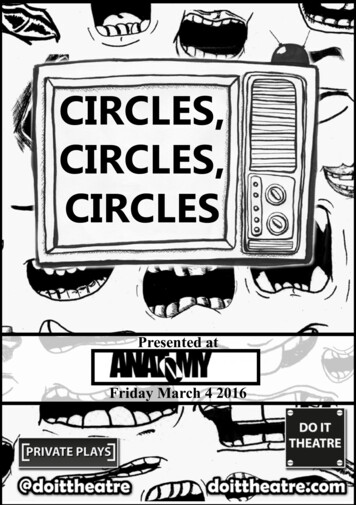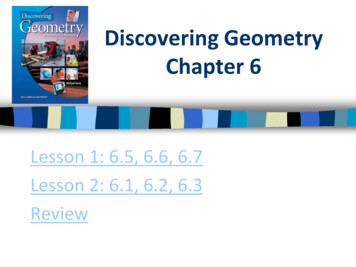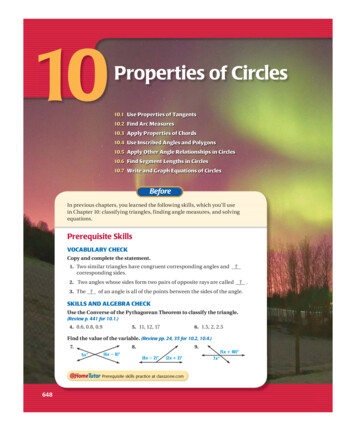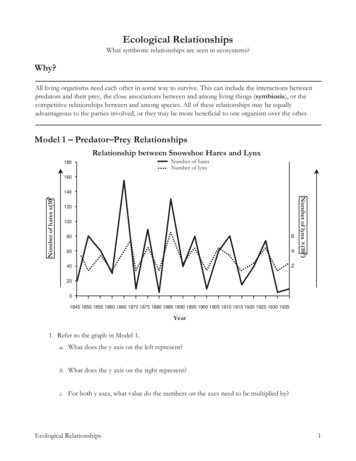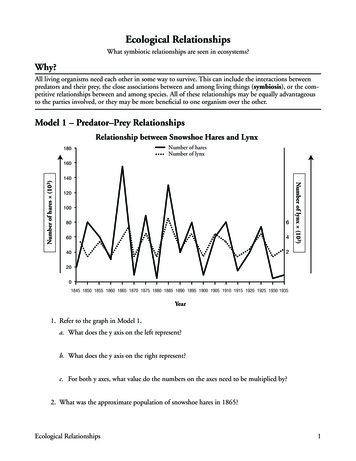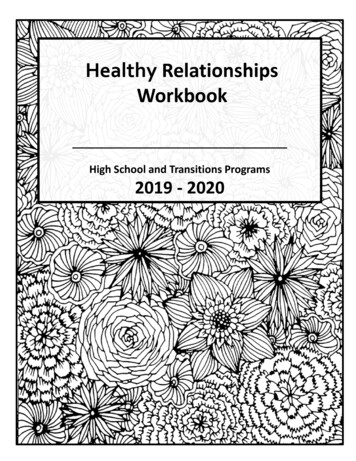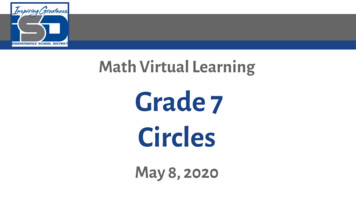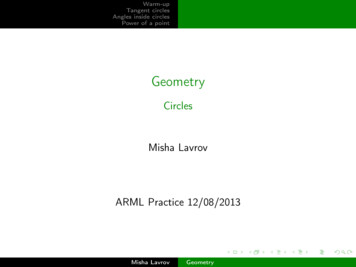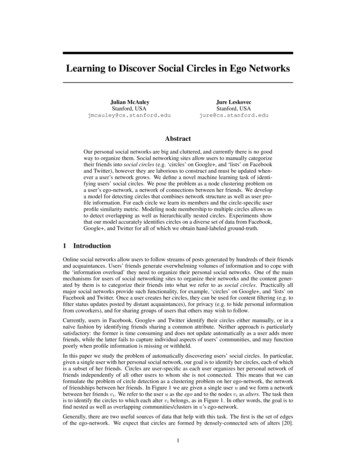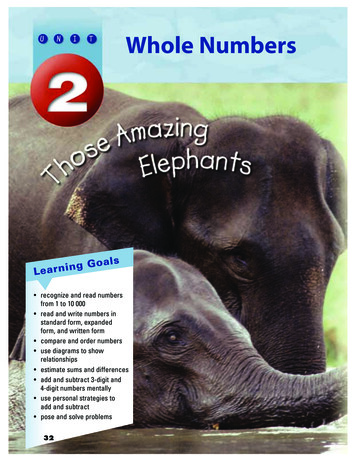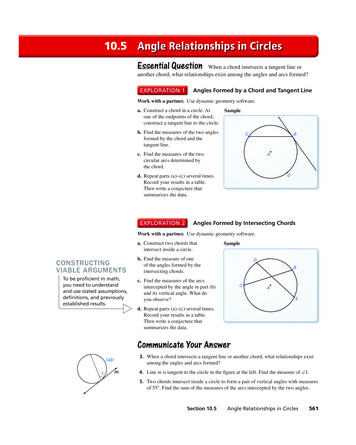
Transcription
Circles ofRelationshipsBuilding-wide Implementation in a Center-based program
Agenda Intro Background on Burger program Background on Curriculum development Why is this important? Phase 1: 2016-2017 school yearBurger’s Sexuality Education Curriculum Overview Scope & Sequence Developmental levelsCircles program Overview Resources available Adapting for individual student needsPhase 2: 2017-2018 school year Focus on increasing personal safety skills Pacing Guide Data collection & progress monitoring
Learning ObjectivesParticipants will learn: The importance of having a comprehensive curriculum to teach socialboundaries and appropriate social relationships to students withdevelopmental delays.About the Circles curriculum.How to implement the Circles curriculum school-wide.How to adapt and expand upon for individual student needs.
Intro Activity:Who’s in the room?-Work in a general education building?Work in a center-based program?School Psychologist?School Social Worker?District administrator?Others?
Burger School for Students with AutismBurger School for Students with Autism is committed to maximizing the potential of each student togain independence and self-fulfillment. Through a collaborative effort we will work in partnership withstudents, each other, parents, community, and local school districts to assure each student has theopportunity to become a happy, healthy, productive, and contributing member of society.Our program is a center-based school for Western Wayne County students an Autism SpectrumDisorder diagnosis. We are located in the Garden City School District and overseen and operated withWayne County Regional Educational Service Agency. RESA oversees the Intermediate SchoolProgramming for Wayne County School Districts. The students range in age from five through twentysix, and we operate in two school buildings.Our program services students in districts of; Allen Park, Crestwood, Dearborn, Trinity, Garden City,Huron Valley, Flat Rock, Livonia, Northville, Plymouth- Canton, Redford Union, Riverview, Romulus,South Redford, Southgate, Taylor, Van Buren, Westwood, Wayne-Westland, and Wyandotte.
Background on Burger’s Sexuality Education Curriculum A Sexuality Education Advisory Committee formed in the fall of 2015 preview additional materials for the prior approved curriculum from May 2010.Primary concern of the committee: Curriculum review- curriculum is based on an original authored by the Gratiot-Isabella ISD Additional materials that would provide appropriate educational images for visual learnersConducted a parent survey Results indicating overwhelming parent support for continuing to teach this curriculumAdvisory committee formed Included; teachers, school social workers, the school psychologist, the Director ofInstructional Services, a nurse, a clergyman, and parents Met on several occasions to openly discuss the topics involved with teaching this curriculum.The primary consideration of all members was for the protection and safety of a vulnerablepopulation of students, personally and socially.In June 2016, the new curriculum materials were board approved the committee developed a plan for its initial implementation phase for the 2016-17 schoolyear.
Why is Quality Sexuality Education important?-Because we are all scxual beings--even students with Autism & Cognitive ImpairmentsBecause young people need facts and skills to make healthy decisionsBecause sexuality education will happen with or without adult guidanceBecause there are many health risks associated with sexual activity includingHIV, other STD’s and unintended pregnancyBecause young people are overwhelmed with conflicting and powerfulmessages about sexualityBecause the law doesn’t accommodate for a person’s disabilityBecause students with disabilities (ASD included) very often do not receiveANY sexuality educationBecause students with ASD are overrepresented when it comes to sexualoffenses, often unintentional
What does research tell us?---73% of 18 year olds with DD said they had sex (Murphy & Elias, 2006)41% of individuals with DD get married4.1 million parents have disabilitiesRate of abuse 2.2 times higher (AAP, 2006)68%-83% of women with DD will be sexually assaulted in their lifetime & lessthan half of them will seek assistance from legal or treatment services(Disability Justice Initiative, 2003) than 90% of people (male & female) with DD will experience physical orsexual abuse at some point in their lives. (Valenti-Hein, D. & Schwartz, L.(1995)Offenders are often family members or caregivers
Turn and Talk-What level of sexuality education do special education students in yourdistrict receive?Are social boundaries and relationships specifically taught?-If so, what is being taught?How is it being taught? ( who is teaching, what setting etc.)Be ready to share out!
Phase 1: Implemented 2016-2017 Building wide- BB & BTCCircles monthly pacing guide Monthly themes & activitiesAll staff training at beginning of school yearBarb Flis- Wayne RESA consultant: HIV-STD training on PD day & TalkEarly Talk Often evening training for ParentsParents received letter at beginning of the year & were able to viewcurriculum materials at Open House
Burger’s Sexuality Education Curriculum:Scope & Sequence-Anatomy & PhysiologyPersonal HygieneSelf AdvocacyInterpersonal CommunicationRelationship DevelopmentHealth ConcernsCommunicable Disease Including HIV/AIDS and Sexually TransmittedDiseasesNon-acceptable Sexual ExpressionLegal Issues (Teen and Young Adult only)
Parent permissionRequired only for the following topics:-PubertyReproductive HealthContraceptive strategiesRights and responsibilities of sexual expressionAn Opt Out form send home to parents with introductory letter at the beginningof the year.
Burger’s Sexuality Education CurriculumDevelopmental Levels-Preprimary (age 3-6)Primary (age 6-10)Intermediate (age 10-15)Teen (age 14-18)Young Adult ( age 18-26)-Depending on students’ cognitive levels, staff can be flexible on which level ofinstruction you teach“I can statements” aligns with scope & sequence of the curriculum
Barriers to implementationLessons learned from year 1:1.2.3.Staff buy-in essential for successAdministrative support and enforcement essential for successIt’s a team effort, the committee needs to include staff invested in beingproductive
Circles- What is it? The Circles Curriculum, developed by James Stanfield Co., focuses onteaching social and relationship boundaries, interpersonal skills andrelationship-specific social skills.The program uses a simple multi-layer colored circle diagram todemonstrate the different relationship levels students will encounter in dailylife.Starting from the center circle, which is self, each new color representsbehaviors, feelings, and actions appropriate to the distance from the centeror self.
Strangers, Community Helpers & Health workersChildren not in my familyAcquaintancesFriends & Distant relativesClose FamilySweetheartSelfRELATIONSHIPCIRCLESTeaches Boundaries ofTalk, Touch, Trust
Circles- Why it’s useful Circles is a concrete, organizational paradigm for students with specialeducational needs that helps them learn to act and interact inself-enhancing ways. This curriculum uses principles of behavioral psychology and proventechniques in special education that help students to generalize theirlearning across many settings: school, home, social and vocational.
Benefits of implementing Circles common language utilized across settingsopportunities to teach appropriate social boundaries across settingsprovides a context to discuss difficult issuesprovides students with the tools to advocate for themselves.can easily be incorporated with school-wide PBIS expectations as it teachesappropriate social skills
The 3 T’s of Circles
Purple Private Circle-The center circleKey Concepts:--Places for privacy--Everyone has their own purple private circleYou are the most important person in your worldNo one touches you unless you want to be touchedBedroom & BathroomExtending the curriculum:-Public vs. private (places & activities)Personal HygieneSelf- AdvocacyAppropriate sexual expression
Blue Family Circle-Who: Close family (parents, siblings)--Sweethearts (girlfriend or boyfriend)Talk: Share personal & private news, questions, feelings or thoughtsTrust: Full trustTouch: Close hugs, kissesExtending the curriculum:-Interpersonal SkillsRelationship development
Green Circle-Who: Close friends & distant relatives ( ex. grandparents, cousins)Talk: Personal newsTrust: Full trustTouch: Far away hugs, brief touchExtending the curriculum:-Interpersonal SkillsRelationship development
Yellow Circle-Who: Acquaintances (Neighbors, teachers, bosses)Talk: Small talk, not personal or private topicsTrust: Limited trustTouch: Hand shake, High 5Extending the curriculum:-Interpersonal SkillsContinue Relationship DevelopmentAnatomy and Physiology- Health Concerns
Orange Circle-Who: Small children (not in your family)Talk: No talk, no conversationsTrust: No trustTouch: No touch, wave and smileExtending the curriculum:-Legal Issues
Red Circle-Who: Strangers (Community Helpers, Health Care Workers, Total Strangers)Talk: No talk (Total Strangers) or business talk (Community Helpers &Health Care Workers)Trust: No trust (Total Strangers) or limited trust (Community Helpers &Health Care Workers)Touch: No touch (Total Strangers) or business touch only (CommunityHelpers & Health Care Workers)Extending on the curriculum-Self-AdvocacyRelationship DevelopmentInterpersonal Communication
Resources available to support teaching Circles Manual Google Drive Visuals & Social storiesActivities Folders for each CircleVideos Hardcopy: Can be borrowed from SW/PsychVirtual copy: Available in Google DriveCircles Level 1Circles Level 2Circles Stop AbuseCircles App
Examples of extending the curriculum-Visual supports (Pic Sticks from ULS,Boardmaker)- Social stories- Personal Diagrams
Social Story Example:
This circle is all aboutME!I decide who can touchme and when and whereI’m okay with beingtouched.I am responsible with myprivate parts and am sureto be modest.
This circle is about hugsand kisses. This circleincludes my Mom, myDad, and my sisters orbrothers and mygrandparents.I can hug and kiss thesepeople because I love tothem and they love mejust as much.
This circle is about who Ihug but don’t kiss. Thisincludes my aunts,uncles, cousins andfriends.I can hug these peoplebecause they’re a part ofmy family or my closefriends but I don’t kissthese people.
This circle is about who Ionly touch with ahandshake or high-five.These are people I knowbut who I’m not veryclose with. There are alot of people who are inmy handshake andhigh-five circle like myparents friends, myschool principal, and myteachers to name a few.
This circle is about who Ican wave at but shouldn’ttouch. I wave and sayhello to these peopleinstead. I do not need totouch them. Some of thepeople who I wave to arepeople passing me in ahallway, a neighbor kid,and young children.
This circle is all aboutpeople I do not need totouch at all. People inthis circle may bestrangers. I do not touchthem. Some people inthis circle include theserver at a restaurant,someone at a store orpeople in the community.
It’s important to remember whoI can trust, talk and touch.The circles will help me findmy way!
Turn and Talk-Can you think of a student or group of students with special needs in yourdistrict that would benefit from the Circles curriculum?How can you incorporate this curriculum into your current practice?Be ready to share out!
Phase 2: 2017-2018Focusing on increasing personal safety skills-Linked to a School Improvement GoalContinuing to teach Circles CurriculumAdding in objectives from Sex Ed Curriculum--Updated Monthly Pacing GuidePre-post test--Self AdvocacyInterpersonal CommunicationRelationship DevelopmentCheck points throughout the yearAdditional parent training & involvementMonthly Circles newsletter for staff & parents-Featuring AHA moments
Monthly NewsletterMonthly Pacing Guide
Pacing Guide-Monthly guide to Circles & Curriculum topics--Circles themed months to continue throughout school yearCurriculum Concepts built into Circles to take this a step further--Will be given out one month at a time with September as a preparation & overview monthWill focus on personal safety goal for all studentsCurriculum activity ideas/pages added to monthly pacing guideEncourage teachers to “dig into” the curriculum and use board approved resources to planown lessonsLessons to be appropriate to age and developmental level of your studentsData collection added, in September, December, March and JuneBuilding teams available to work with teachers in formal and informal ways
Pre- Post test-15 Multiple choice Questions--Matching (visual) assessment option for lower functioning studentsBuilt in testing windows into pacing guide--Visual supports for answers to provide nonverbal responsesCheck-ins throughout the yearData collected by committee to utilizeData will be used for school improvement goal-Teachers encouraged to use for SGI’s or Individual Development Plan
Examples of Pre/Post test Questions with visuals
Thoughts?-Thoughts from you?-Things to think about:- What excites you about this idea?- What barriers do you anticipate?- What needs does your program have?- What will you need to carry this out?- What are your next steps?
Questions?Contact Information;Patrizia Severy- Burger Baylor Social Workerseveryp@gardencityschools.comAlison Arnold- Burger Baylor & Burger Transition Center School Psychologistarnolda@gardencityschools.com
teaching social and relationship boundaries, interpersonal skills and relationship-specific social skills. The program uses a simple multi-layer colored circle diagram to demonstrate the different relationship levels students will encounter in daily life. Starting from the center circle, which is self, each new color represents
